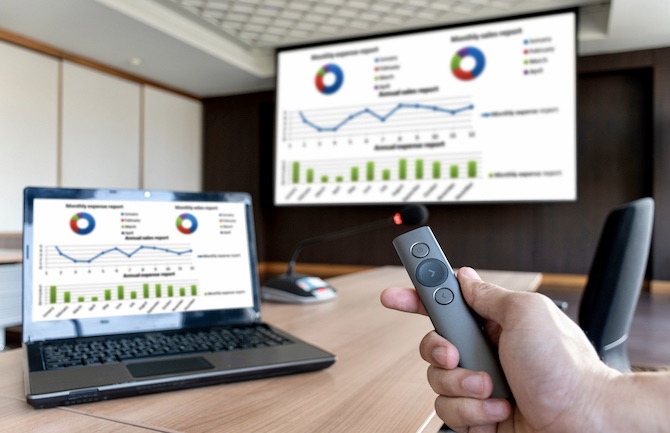
How a smart meeting room can improve your office
Did you know that employees will spend an average of 12 hours of their 40-hour work week preparing for or attending meetings? And those meetings can often be ineffective, which ultimately costs your company money. So what’s the best way to ensure you’re getting the most out of your meetings? Incorporating a smart meeting room into your office design can make a massive difference. Read on to learn more about the benefits of smart meeting rooms.
What is a smart meeting room?
Before we dive into the benefits of smart meeting rooms, let’s break down exactly what they are. Smart meeting rooms are conference rooms and meeting spaces powered by technology that can help make your meetings more dynamic and collaborative.
So, the big question now is how does having smart conference rooms benefit you?
What are some smart meeting room benefits?

It might seem like a simple thing: adding technology to your meeting rooms. But that simple action can reap big rewards.
Smart conference rooms improve engagement
Boring meetings are the worst. Nobody wants to attend a meeting where the presenter just talks away, droning on without any kind of visual aid. This kind of meeting is the perfect way to get your employees to daydream and zone out.
But in a smart meeting room, projectors or televisions hooked up to computers can help attendees visualize concepts and talking points. Or for more collaborative meetings, smart whiteboards can be the perfect tool for brainstorming. Meetings can be so much more than lectures, and smart conference rooms can help get everyone involved.
They facilitate remote and hybrid meetings
We’ve all been adjusting to the new ways of working over the last few years. And a big change for many is the switch to a hybrid work model. While hybrid work has many benefits, it also comes with unique challenges. For example, holding hybrid meetings is a big shift for many businesses.
Installing quality audio and video equipment in your conference rooms makes it possible to hold hybrid meetings that feel inclusive for in-office and remote workers. Using the right tech can help you save time, reduce travel expenses, and streamline the meeting planning process. Smart rooms can help employees at home, in the office, and collaborators from other companies have a productive meeting.
They help maximize use of office space
Have you ever walked into a conference room to set up a meeting, but it’s already in use by another team? Frustrating right? And this could be embarrassing if it happens when visitors attend your meetings.
Smart meeting rooms are great because they allow you to book and reserve rooms well in advance. They can help reduce friction between employees and eliminate booking conflicts. Plus, if you incorporate smart digital signage into your design, anyone can see if a room is booked or open at a glance.
Smart conference rooms can record meetings
Ever missed a meeting because you were unavailable? Maybe you were busy with another client, traveling, or home sick that day. With smart conference rooms, it’s possible to record meetings and send the files to anyone who can’t attend.
Absent employees can go through the whole recording if necessary, which is a major step up from a quick briefing from a coworker or reading someone else’s meeting notes. Recording meetings can help all the relevant decision-makers make fully-informed choices, even if they can’t attend on the day.
6 things to include in your smart conference rooms

Now you know about some of the ways smart meeting rooms can improve the conference experience, let’s look at some of the best technology you need to incorporate into your design.
Video conferencing software
Using the right video conference software in the hybrid work world is essential and should be number one on your list.
Thanks to the pandemic, everyone and their grandmother are familiar with Zoom. Zoom also offers Zoom Meetings for business use which will be a better option for your smart meeting room. There are plenty of other options available, including Microsoft Teams, Webex by cisco, and Google Meet. The best approach is to look over each software’s features and decide which matches your needs. Larger, enterprise-level companies will benefit from a more robust system like Webex or Teams, while smaller companies can probably make do with less substantial offerings.
After choosing the right software solution, take some time to set it up and test it out before you need to use it in a meeting. That way, you’ll know that everything works, and you can familiarize yourself with the system before you really need it.
Cameras
You’re probably used to dialing into meetings with your webcam. While this may work well enough for a team of two or remote participants, it isn’t ideal for meeting rooms.
Instead, it’s best to get a conference camera that can capture everyone attending in-office. There are several different styles of conference room cameras you can try. Cameras that mount under a video screen can easily capture everyone in a large room. And 360-degree cameras that sit in the middle of your conference table can help remote participants feel like they are in the room.
Smart whiteboards
Whiteboards are a main staple in any office because they’re great for collaborative meetings and brainstorming sessions. And smart whiteboards can be a great upgrade to the old standard.
Smart or interactive whiteboards can open up a new world of collaboration thanks to their ability to accept digital inputs, connect to the internet, and play different media types. And notes taken on smart whiteboards can be saved and distributed to meeting attendees to peruse later. They offer great options for companies looking to design smart conference rooms.
Smart sensors
Smart sensors like occupancy detectors are an excellent option for smart meeting rooms. These sensors can tell when a room is in use, how many people are there, and can automatically adjust things like lights and heating systems. Smart sensors are a perfect way to save on conference room energy costs. They are also handy to ensure you’re not exceeding the recommended safety and public health guidelines for occupancy.
And incorporating smart sensors into your meeting rooms can give you valuable information about room utilization, letting you adapt your office plan and change anything that doesn’t work.
Digital signage
As we mentioned above, digital signage is helpful for workers in-office. Digital signs can display conference room names, whether the room is in use or empty, and can display important information like occupancy limits.
Digital signage that integrates with an office-wide scheduling solution will update automatically and display important information in real-time.
A meeting room scheduling and booking software
Scheduling and booking software is perhaps the most critical part of creating a truly smart meeting room. These programs track room usage, integrate with email and calendar software to book and release rooms as needed, and send information to your digital signage. The right scheduling software helps everything run smoothly and helps you make the most of all the technology packed into your smart conference rooms.
Smartway2: The smart workplace scheduling solution
Here at Smartway2, we’re all about leveraging technology to create a better workplace. We can help you take your conference rooms to the next level with Microsoft Office integrations, digital signage, smart analytics, and more.
Request a demo today to see Smartway2 in action!


